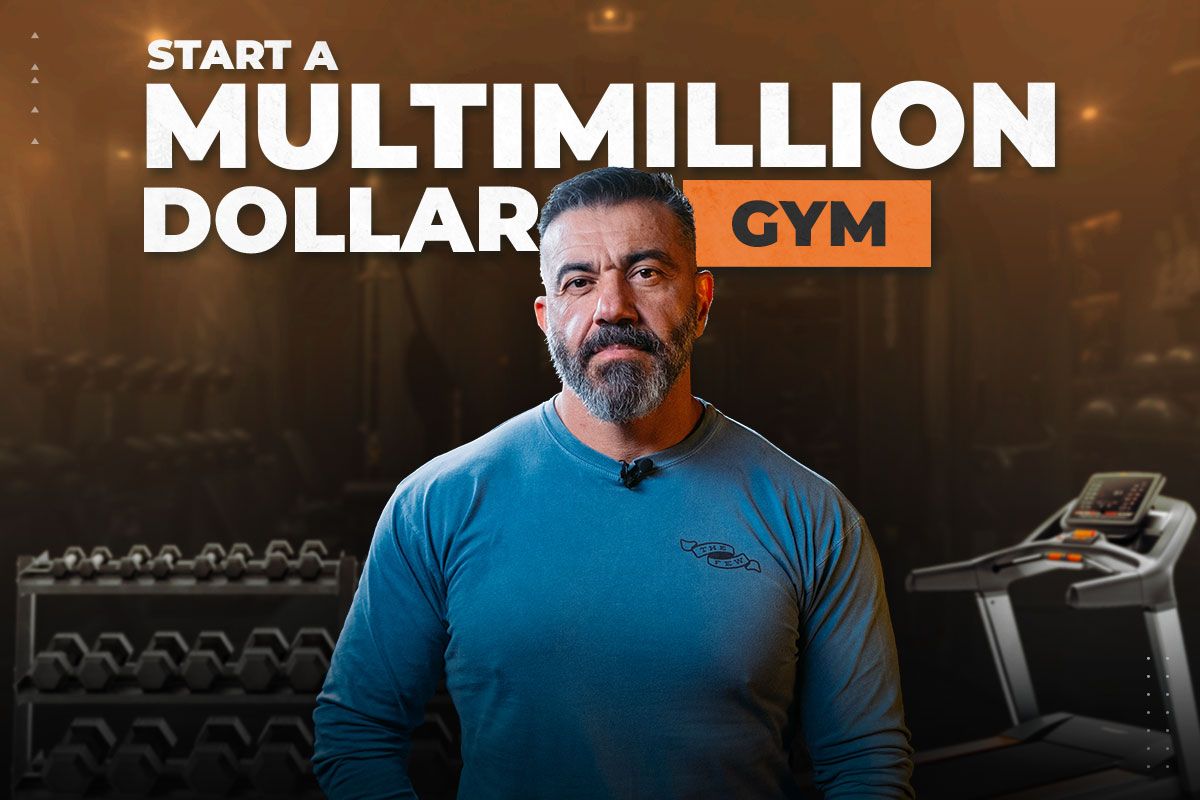Do you love fitness and say to yourself, “Wouldn’t it be awesome to open my own gym?” Anything is possible!
We interviewed Bedros Keuilian, founder of the Fit Body Boot Camp franchise. Bedros demonstrates that having the right mindset is a key part of successfully launching your own business.
In an exclusive interview, he shares his story of going from eating out of dumpsters to making $200 million per year. Best of all, he explains what it takes to open a gym and become a leader in your industry.
By following the steps already taken by Bedros, you can easily learn how to start a gym from scratch. Keep reading or click on any of the links below to jump to the section that interests you:
- Learn About the Fitness Industry
- Case Study: Fit Body Boot Camp
- Step #1. Write Your Gym Business Plan
- Step #2. Get Certification
- Step #3. Estimate the Startup Costs
- Step #4. Create Your Pricing Strategy
- Step #5. Meet the Legal Requirements for Opening a Gym
- Step #6. Seek Financing
- Step #7. Choose a Business Location
- Step #8. Get Gym Licenses and Permits
- Step #9. Purchase Gym Equipment and Management Software
- Step #10. Start Marketing Your Gym
- Step #11. Provide Excellent Customer Service
- Starting a Gym FAQ
- Ready to start your own gym?
Learn About the Fitness Industry
You need to understand the industry before you start a fitness business. We’ll discuss some of the financial considerations in the following sections. All results are from the UpFlip Academy industry database unless otherwise noted.
How much does it cost to open a gym?
The average cost to open a gym is $75,000 with a range between $5,000 and $3.6 million. The costs involved with opening a gym will vary based on your location and the type of gym you want to open. For instance, fitness gyms in larger cities may have higher rental or mortgage costs than locations in suburban and rural areas.
Below are the startup costs for different types of gyms that business owners have decided to open:
• Personal home training gym: $5K to $10K
• Specialty studio: $75K to $250K
• Personal training studio: $50K to $100K
• Small fitness studio: $100K to $250K
• Franchise gym: $150K to $3.6M
The costs can be divided into one-time or ongoing expenses.
One-time costs
These costs are for business expenses that you have to pay infrequently, such as:
- Gym equipment and supplies
- Certifications
- Licenses and permits
- Legal and processing fees
- Signage
Most of these expenses will either be one-time costs or when something changes for your business.
Ongoing expenses
These are the monthly expenses that you’ll need to pay to run a successful gym:
- Mortgage or lease
- Advertising and marketing
- Insurance
- Repairs and maintenance
- Phone and internet service
- Payroll
- Miscellaneous or unexpected expenses
Are gyms profitable?

Gyms are profitable with an average net profit margin of 11.25%. Profit margins range from 10% to 55.8% depending on location, services, and number of memberships. Here’s a basic overview by type of gym:
• Boutique fitness studios: 20% to 40%
• Traditional gyms: 10% to 15%
• Franchise gyms: 10%
• Specialty studios: 20% to 30%
The major players in the fitness industry have profit margins that are 11.2% to 55.8%. Many of the gyms with 55.8% profits are because they’re actually franchising companies. I suggest doing thorough market research on the top players to better understand their financial benchmarks.
How much do gyms make?
Gyms make an average of $275,000 revenue per year, but many of the top gyms in the fitness industry make millions or billions annually. Bedros told us:
How much do gym owners make?

The average gym owner makes an estimated $90K per year. This, however, can vary by state. Owners in Washington, for example, may make about $80K per year, while gym owners in Iowa may make around $60K.
There are exceptions to this since location and pricing can also make a huge difference in overall annual income.
Case Study: Fit Body Boot Camp
Bedros Keuilian moved to the United States with his family when he was a kid. They struggled to pay the bills, which taught him to juggle what he needed.
He started Fit Body Boot Camp because he loves fitness and wanted to provide gym members with an efficient way to work with a personal trainer. His centers have group fitness instructors who teach 30-minute classes that are intended to help you burn calories faster and keep burning them throughout the day.
His gyms don’t have any complicated fitness equipment or cardio machines that run on electricity. This reduces costs like utilities and equipment maintenance.
For more insights, check out our interview with Bedros below:
Step #1. Write Your Gym Business Plan
You’ll want to write a solid business plan to help you make better decisions. First, you need to decide what business ideas to pursue. Bedros explained his philosophy:
You’ll want to start carefully planning how you will start the gym and operate the business. When writing a business plan, make sure to include the following:
- Executive summary
- Company description
- Products and services
- Market analysis
- Marketing strategy
- Budget
- Financial projections
Check out our blog about how to write a business plan.
Step #2. Get Certification

You might need certifications when opening a gym. A fitness club offering yoga and pilates, for example, may require specific certifications to teach those classes.
There are several organizations that offer gym certifications:
- American Council on Exercise
- National Council on Strength & Fitness (NCSF)
- National Strength and Conditioning Association (NSCA)
- National Academy of Sports Medicine (NASM)
- International Sports Sciences Association (ISSA)
- American Fitness Professionals and Associates (APFA)
- International Fitness Professionals Association (IFPA)
Step #3. Estimate the Startup Costs
You’ll need to estimate the startup costs before opening your fitness center. Start with these four areas to calculate the cost of opening a gym:
- Determine expenses: Take all necessary and potential expenses into account. Include rent, equipment, and staffing.
- Conduct research: Research competitors to get a better idea of what it costs to operate a gym or fitness center in your area.
- Organize costs: Classify expenses as either one-time and monthly costs.
- Confirm the total: Add up everything for a full tally of expected costs.
These are the most common costs to factor into starting a gym business:
- Type of gym
- Size
- Location
- Equipment
- Legal fees
- Business insurance
- Marketing and advertising
- Rent or mortgage
- Utilities
- Remodeling fees (if applicable)
Step #4. Create Your Pricing Strategy

Next, you’ll want to create a pricing strategy for your fitness center that will help you make a profit selling gym memberships.
A quick Google search will show that most gym owners charge between $40 and $70 per month. Low-end gyms may charge as little as $10 monthly, while high-end gyms may charge up to $200. You’ll probably want to be in the sweet spot when opening a new gym.
Typically, your gym should offer one or more of the following:
- Monthly memberships
- Classes for large, medium, or small groups
- One-on-one personal training
Consider the length of time that people are working out, the number of stations you have, and your hours of operation. For instance, if you have 100 stations, that means the maximum number of people who can use your fitness facility at one time is 100.
Assume those 100 people use the fitness equipment one day a week for half an hour. If your fitness business is open eight hours a day, that means your maximum client list for that space would be approximately 11,200 people.
Take the monthly expenses you calculated earlier and divide them by the maximum number of clients you can support. That will provide your break-even point.
Step #5. Meet the Legal Requirements for Opening a Gym
The first step is to choose a business structure. Most gyms are set up as limited liability companies (LLCs) or corporations to protect you from liability.
This way, your personal assets are protected if the gym gets sued. Sole proprietorships don’t have the same level of protection.
Once you’ve decided on a structure, there are six key tasks you’ll need to complete to legally open a gym. Let’s discuss each one in greater detail.
Choose a Gym Business Name
When choosing a business name, make sure it’s memorable and easily scalable for when it’s time to expand. Here are a few things to consider before settling on a name:
- Make sure the name is available for registration and as a domain.
- Use a simpler name to make it easier to find your gym on the internet.
- Look at the competition to ensure the name isn’t a similar copy.
- Create a name that’s easy to remember to help you with brand recognition.
Register Your Gym Business

It’s important to register your own gym business or in order to obtain the following benefits:
- Liability protection: When you register a business as an LLC or a corporation, it forms a separate legal entity.
- Credibility: Legally registering your gym shows that you’re a professional who knows what it takes to operate a business.
- Tax benefits: Officially owning a business creates opportunities for tax deductions on start-up and development costs.
- Access to capital: If registered, your fitness business may be able to qualify for financial assistance such as small business loans or grants.
Get Federal and State Tax IDs
Tax IDs are like social security numbers for businesses. At the federal level, you’ll need an employer identification number (EIN) from the Internal Revenue Service.
A state employer ID is the state’s version of a federal EIN and serves the same purpose. A state tax ID can also help businesses qualify for licenses and permits.
Businesses that are registered as sole proprietorships or single-member LLCs are not required to apply for an official tax ID.
File a Beneficial Ownership Information Report

This is an informational document that confirms who owns or controls the company as well as their percentage of ownership. This document is used for the benefit of the U.S. government to help monitor for illegal activities such as money laundering or tax fraud.
Open a Business Bank Account and Credit Card
Opening a business-specific bank account and credit card will help you keep your business assets separate from any personal assets. This allows you to easily organize and track expenses and other transactions to avoid confusion.
A business credit card will also allow you to build credit for your company.
Get Business Insurance
Insurance protects you in the event of bodily injury, property damage, and reputational damage. If you don’t purchase business insurance, it could cost you thousands to resolve an incident whenever something goes wrong. Remember that gym businesses have a higher level of risk from people exercising on the premises.
Step #6. Seek Financing

When starting a business, there are several ways to achieve financial support.
Self-Funding
Self-funding, or bootstrapping, is the most common way to start a new business. However, opening a gym costs $75,000, which means you may need to consider other options.
Family and Friends
Getting money from family and friends is a great option if you’re looking to get a loan from those you know and trust. These can be informal loans, and therefore, flexible with the overall repayment terms.
Small Business Loans

A small business loan may be a great option. A local bank or credit union can provide loans backed by the Small Business Administration (SBA). You’ll normally need to put at least 20% down to qualify.
Venture Capital
If you’re looking for multiple hands in the business, venture capitalists will provide equity in exchange for an ownership stake in your company.
Crowdfunding
Often conducted remotely, this option allows you to raise small amounts from a large number of people. This option may be helpful if you don’t have local resources or family to support you.
Bedros thinks that getting a business started is easier now than ever before due to greater access to funding resources:
Step #7. Choose a Business Location

You’ll need to choose a business location for your new gym. Consider the following factors when choosing a business location:
- Proximity to your target audience
- Competition
- Zoning laws
- Costs
- Growth potential
Bedros thinks that you should be particular about choosing your business locations in case you want to scale in the future:
Step #8. Get Gym Licenses and Permits
You’ll need to get gym licenses and permits to open your business. Your location, services, and business model will impact what licenses are required. However, you’ll most likely need the following licenses and permits before opening a gym space no matter the type:
- Business license
- Zoning permits
- Health department permits
- Fire department permits
- Music licensing (if the gym plays music)
- Personal trainer certifications
- Sales tax permit
Step #9. Purchase Gym Equipment and Management Software

You’ll need to get new equipment and software while opening a gym. The type of equipment you’ll want will vary based on the type of gym you open, but these items are the most popular:
- Free weights
- Benches
- Resistance machines
- Gym mats
- Treadmills
- Stationary bikes
Some of the best websites to purchase commercial gym equipment include:
In addition, gym management software helps you automate workflows so that your employees can focus on other areas of the business like marketing and customer service.
These are a few great software management systems to consider:
Step #10. Start Marketing Your Gym
There are several benefits to marketing your business. When first starting any kind of business, you’ll want to invest your time in marketing for the following reasons:
- Creating brand awareness
- Building your brand image
- Driving sales
- Gaining and retaining customers
- Educating potential customers on your services
- Getting customer feedback
Bedros utilizes various platforms to market his business including WordPress, Shopify, social media, and paid advertising. If you don’t have a marketing budget, Bedros says there are plenty of ways to get around spending additional money in the beginning:
You could also offer a free personal training session to new members to get more attention for your gym. If you need more marketing support as you figure out how to open a gym, sign up for our Google Ads for Beginners course in the UpFlip Academy.
Step #11. Provide Excellent Customer Service

Above all else, make sure that you’re always providing excellent customer service. This will generate customer loyalty, increase your revenue, and give you a competitive advantage.
Here are several ways fitness centers can provide exceptional customer service:
- Celebrate member milestones.
- Quickly respond to inquiries or concerns.
- Be patient with everyone, especially with new customers who are still learning about the facility and equipment.
- Ask for feedback.
- Personalize communications to show genuine interest and care.
Starting a Gym FAQ
Let’s take a look at some frequently asked questions that customers and business owners often have about gyms.
How often should you go to the gym?
You should go to the gym and aim to get an hour of exercise three to five times per week. When you first start, ease yourself into a workout routine and get proper training if you don’t know how to use equipment or do an exercise safely.
Can a gym membership be a business expense?

No, a gym membership isn’t a business expense for most people. Professional athletes that spend the majority of their time training and practicing for events will likely be able to count a membership with their local gym as a business expense.
How to value a gym business
To value a gym business, you’ll want to evaluate the business based on the number of memberships and your assets. Make sure to include the building and equipment.
There are a number of ways of determining the proper valuation of a business. Try our business valuation calculator for more information.
Ready to start your own gym?
Starting your own gym requires a clear vision, specific licenses, and equipment. With the right drive and a smart financial strategy, you can open up fitness studios, start gym franchises, and more.
What type of gym do you plan to open? Let us know in the comments below.





